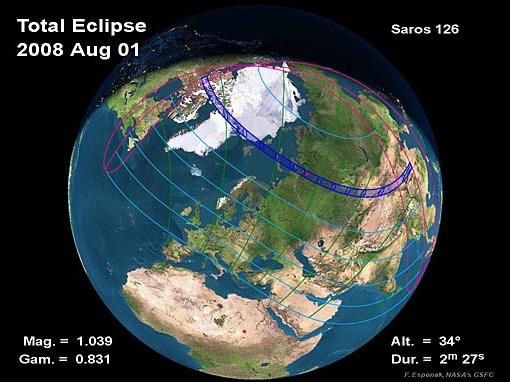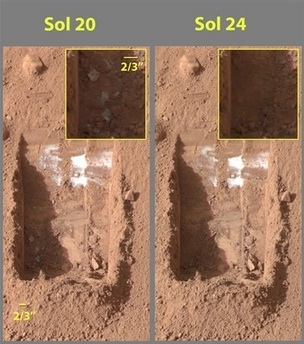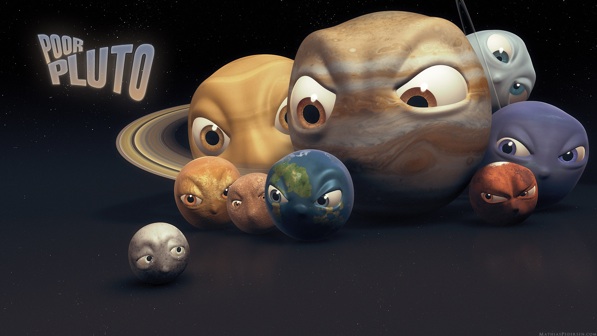The View From LA
The conjunction of Jupiter (top), Venus (middle) and the waxing crescent moon (er, […] Click to continue reading this post
The conjunction of Jupiter (top), Venus (middle) and the waxing crescent moon (er, […] Click to continue reading this post
Tomorrow night and the night after (Sunday and Monday), you should look West just after sunset, if you’ve a clear sky. There’s going to be a rare conjunction of Venus, Jupiter, and the crescent moon. Already, Jupiter and Venus look great together (they make a lovely couple) each night, but the trio – the three brightest objects in the […] Click to continue reading this post
You’ll perhaps recall that a few days ago I mentioned some upcoming science shows in which I talk about various science ideas. I said, among other things:
[…] one is called Parallel Universes and the other is called (I think) Light Speed, both doing more or less what it says on the packet. I’ve not seen the final cut of either show this time, so I’ll be curious to see how they put the material together. They’ll air in the upcoming new season of the series, on the 18th November and the 25th November, respectively. I think – not 100% sure – that is all that is coming up from me on that series for the rest of this year (there is another thing due on that channel in December, and then that’s certainly enough of me showing up in your living rooms for a while), not counting the reruns […]
Well, I was wrong about the latter. It is on Monday, I was recently informed! This is, i think, going to be a really very good documentary on Einstein and his work, from a somewhat different angle than maybe you’ve seen before. It’ll focus quite a bit on the ideas and concepts and, importantly, the process by which Einstein developed his […] Click to continue reading this post
Well, this is a significant bit of news! Look at this: […] Click to continue reading this post
 As you may have heard, the Phoenix craft on Mars (remember? seven minutes of terror?) which had already been running beyond its design lifetime, has probably sent its final message from Mars. There is not enough daily solar energy (now that it is Winter) coming in to support its energy needs.
As you may have heard, the Phoenix craft on Mars (remember? seven minutes of terror?) which had already been running beyond its design lifetime, has probably sent its final message from Mars. There is not enough daily solar energy (now that it is Winter) coming in to support its energy needs.
There’s a NASA press release here, with links to the mission pages for a reminder of […] Click to continue reading this post
Apparently it snows on Mars. No, really! Another finding from the amazing Phoenix craft. More here. A snippet:
Click to continue reading this post
 There were three excellent presentations under the theme Bubbles at the most recent Categorically Not! at the Santa Monica Art Studios. See here. The final one was a visual treat which got everyone on their feet applauding at the end. It was Sterling Johnson, lawyer by day, bubble superhero by night, showing us some of his superpowers. I captured some clips of it, and edited them together for you. (Sorry about my laughing into the microphone at one point. I couldn’t help it.)
There were three excellent presentations under the theme Bubbles at the most recent Categorically Not! at the Santa Monica Art Studios. See here. The final one was a visual treat which got everyone on their feet applauding at the end. It was Sterling Johnson, lawyer by day, bubble superhero by night, showing us some of his superpowers. I captured some clips of it, and edited them together for you. (Sorry about my laughing into the microphone at one point. I couldn’t help it.)
My two favourite moments are at 5:28 when he does his “Invisible Bubble Trick” -it is […] Click to continue reading this post
 This is quite remarkable. There’s actually been an image (see left) taken of a planet orbiting another star. There are hundreds of known extrasolar planets in orbit around other stars (see lots of earlier posts), and evidence for them has been indirect, since they are too tiny and too dim (having no light of their own) to image directly. You can learn of their existence by their effects on their parent star, and/or on the light it casts. (The image left is courtesy of the Gemini Observatory. The University of Toronto scientists used the Gemini North telescope on Mauna Kea in Hawaii and its adaptive optics technology to make the image.)
This is quite remarkable. There’s actually been an image (see left) taken of a planet orbiting another star. There are hundreds of known extrasolar planets in orbit around other stars (see lots of earlier posts), and evidence for them has been indirect, since they are too tiny and too dim (having no light of their own) to image directly. You can learn of their existence by their effects on their parent star, and/or on the light it casts. (The image left is courtesy of the Gemini Observatory. The University of Toronto scientists used the Gemini North telescope on Mauna Kea in Hawaii and its adaptive optics technology to make the image.)
But this is different, and a bit of a milestone. These astronomers released an actual […] Click to continue reading this post
Just the other day, while coordinating some work being done on my house, I was thinking that it is time I learned Spanish. Most of the people working in the construction industry here in Los Angeles have Spanish as their first language, and besides the usefulness it would give in communicating difficult ideas about a piece of work to be carried out, I really don’t like the feeling that I’m disconnected from them. I’d like to be able at least to, in Spanish, offer a cup of coffee, or a glass of iced water, and have a little small talk – treat them like fellow human beings as opposed to “the help” as is done so much in this city, to my disgust. I interact a lot with the Spanish-speaking parts of the city through my use of public transport, places I go to grab tasty food from time to time, and so on, but there is still a sense that there is an entire alternative Los Angeles out there that I am only barely touching upon by not knowing the language.
Then yesterday this whole Spanish language issue came up again in a big way. There was a phone call to the department from Univision, the Spanish-language TV network. Probably most of you are wondering what that is. You know those several channels that you never watch and when you flick by them, all clustered together, they’re always speaking Spanish and discussing issues or people that you seldom (if ever) have heard of? Yes. This is one of those channels. There’s a huge part of America (and elsewhere) that tune to those channels primarily.
Well, the people at Univision had heard about the excitement about the Large Hadron Collider (see, e.g. last post) and wanted to do a piece on it, and have someone in the studio to talk about it live on their breakfast show. They were looking for a […] Click to continue reading this post
Well, the new orbiting instrument, GLAST (Gamma-ray Large Area Space Telescope – launched June 11th this year) has passed all its tests with flying colours, apparently, and is working well. NASA has now renamed the craft the Fermi Gamma-ray Space Telescope, after Enrico Fermi. There’s a press release here.
The craft is a wonderful combination of the fields of particle physics, astrophysics and cosmology, and will teach us so much about the universe (such as the nature of dark matter), and so it is exciting to hear that it all on track.
Excitingly, they’ve also released images of the early results of the observations, and you can read more about them in the press release too. Here’s a sky map made from the observations.
Some words from the release: […] Click to continue reading this post
 Well, you may not have gone to the chat between K C Cole and Leonard Susskind that I mentioned a while ago at the LA Central Library downtown. I couldn’t make it either, being away at the Aspen Center for Physics. I expect it was good. Anyway, I found a little bit of a report on the conversation, done by reporter John Johnson for the LA Times. It is here. (Clickable image of Susskind to the right is by Matthew Black, for the LA Times.)
Well, you may not have gone to the chat between K C Cole and Leonard Susskind that I mentioned a while ago at the LA Central Library downtown. I couldn’t make it either, being away at the Aspen Center for Physics. I expect it was good. Anyway, I found a little bit of a report on the conversation, done by reporter John Johnson for the LA Times. It is here. (Clickable image of Susskind to the right is by Matthew Black, for the LA Times.)
It gives you some of the simply-stated reasons as to why there was a big argument between Stephen Hawking and Leonard Susskind in the first place (and between several other physicists too… there are hosts of people working on these things, and it took hosts of people to sort it out to where we are now, not just those two, giants though they are). I recommend having a look, as it is especially for the lay-person, and will give you a good idea of what the fuss is about.
You can also see a little bit about his new book on the subject and a link to a video interview with Brian Cox (the physicist, not the actor) at the LA Times blogs here. There are also links to his Stanford continuing education course on quantum mechanics, including the online lectures you can view at your convenience. What a resource!
You might wonder why we care about all this, since currently the only way we know for sure to make black holes in the universe (astrophysical processes making stellar black […] Click to continue reading this post
 Don’t forget that there is a total solar eclipse tomorrow. Been wondering where the moon’s been, and why you’ve been having all those lovely clear dark nights perfect for star-gazing? Well, the moon’s been busy preparing for one of its big acts. It’ll pop in front of the sun and bring a little darkness to some regions during the day tomorrow. Put differently, the dark side of the moon will be stealing some of our rays on August 1st.
Don’t forget that there is a total solar eclipse tomorrow. Been wondering where the moon’s been, and why you’ve been having all those lovely clear dark nights perfect for star-gazing? Well, the moon’s been busy preparing for one of its big acts. It’ll pop in front of the sun and bring a little darkness to some regions during the day tomorrow. Put differently, the dark side of the moon will be stealing some of our rays on August 1st.
Who will get to see it? Well, full totality will be available mostly for the “midnight sun” […] Click to continue reading this post
 Have you been keeping track of what Phoenix has been finding on Mars? There’s been lots of digging of holes, baking, peering at things under microscopes, and so forth. And, wonderfully, it has all been guided, monitored, and watched from here on earth. From all of this, there’s now very direct evidence for ice, for example. (Dig a hole, find white flaky chunks which disappear after exposure to sunlight…) (Image left (click for larger) is from the mission (credit: JPL/Caltech/NASA) and shows the before and after. Keep your eye on the darker corner, blown up in the inset.)
Have you been keeping track of what Phoenix has been finding on Mars? There’s been lots of digging of holes, baking, peering at things under microscopes, and so forth. And, wonderfully, it has all been guided, monitored, and watched from here on earth. From all of this, there’s now very direct evidence for ice, for example. (Dig a hole, find white flaky chunks which disappear after exposure to sunlight…) (Image left (click for larger) is from the mission (credit: JPL/Caltech/NASA) and shows the before and after. Keep your eye on the darker corner, blown up in the inset.)
There’s a story from the AFP here, and one by Alicia Chang (AP) here. There’s a photo […] Click to continue reading this post
 I don’t need to remind you about the Pluto reclassification episode of a while back, I’m sure. See posts here, here, and here otherwise.
I don’t need to remind you about the Pluto reclassification episode of a while back, I’m sure. See posts here, here, and here otherwise.
(Right: Mathias Pedersen‘s “Poor Pluto” poster, used with permission. Discussed here previously.)
The International Astronomical Union (IAU) felt the need to reclassify Pluto in the light of ongoing scientific discovery – it’s just one of probably thousands of small objects out there beyond the orbit of Neptune. This area of science is very much alive- we’re learning a lot about the solar system and other planetary systems. (See my post entitled “Clues in the Blood Splatter Patterns”.) The “demotion” led to lots of angry opinion, you may recall.
Well, the IAU’s Committee on Small Body Nomenclature (I love that!) has now decided […] Click to continue reading this post
 Good news everyone! GLAST has been launched successfully. GLAST stands for Gamma-ray Large Area Space Telescope, and it does exactly what it says on the packet. It is an instrument designed to look more closely at gamma rays from outer space. More here. It will help (alongside other instruments such as SWIFT) get better understanding of a wide range of gamma-ray emitting objects, that pertain to a wide range of issues, astrophysical to cosmological.
Good news everyone! GLAST has been launched successfully. GLAST stands for Gamma-ray Large Area Space Telescope, and it does exactly what it says on the packet. It is an instrument designed to look more closely at gamma rays from outer space. More here. It will help (alongside other instruments such as SWIFT) get better understanding of a wide range of gamma-ray emitting objects, that pertain to a wide range of issues, astrophysical to cosmological.
“Gamma ray bursters” are obvious super-powerful sources of gamma rays out there, largely due to macroscopic astrophysical objects (collapsed stars or stars in the process of doing so, or merging with each other – see earlier posts) doing violent things, or interacting violently with their surroundings. So are active galactic nuclei, powered by black holes. We’d like to better understand all of the processes that allow these objects to generate gamma rays.
Other sources could include particles and antiparticles annihilating each other and (by […] Click to continue reading this post